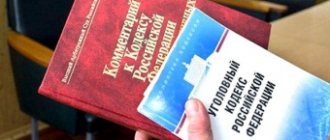Criminal legal characteristics of murder and its types
The attacks of this group include all types of murders, i.e. unlawful deprivation of human life by action or inaction.
An exception is Article 109 of the Criminal Code of the Russian Federation, where death occurs, although from unlawful behavior, but against the will of the perpetrator, and therefore it is not called murder, but causing death by negligence. Nor can incitement to suicide be considered murder (Article 110 of the Criminal Code of the Russian Federation).
These two crimes are included in this group on the basis of the object, despite significant differences in the objective and subjective aspects of the crime.
What is meant by murder?
The current criminal legislation understands murder as the unlawful deliberate deprivation of the life of another person.
Intentional murders according to the degree of public danger are divided into three types :
A) simple i.e. without aggravating and mitigating circumstances (Part 1 of Article 105 of the Criminal Code of the Russian Federation, Article 106 of the Criminal Code of the Russian Federation);
B) qualified i.e. in aggravating circumstances (part 2 of article 105 of the Criminal Code of the Russian Federation, 13 qualifying signs);
B) privileged i.e. under mitigating circumstances (Article 106-108 of the Criminal Code of the Russian Federation).
An attempt on the life of a dead person mistakenly taken for a living person should be considered an attempted murder.
The basic elements of murder without aggravating and mitigating circumstances are provided (Part 1 of Article 105 of the Criminal Code of the Russian Federation).
The object of murder is human life.
The objective side is that murder can be committed either by action or by inaction.
The actions of the perpetrator can be committed in various ways, both through physical and mental influence (fear, mental trauma).
Murder by omission is possible in cases where the perpetrator owes a duty of care to the victim, but intentionally did not do so (example: a mother does not feed her child).
Murder is the material composition between the consequences of the death of the victim and the action (inaction) of the perpetrator, it is necessary to establish a causal relationship.
The subject of the murder is , according to Article 105 of the Criminal Code of the Russian Federation, a physical, sane criminal person at the time of the commission who has reached 14 years of age, for all other types of murder - 16 years.
The subjective side can only be intentional. The perpetrator is aware that he is encroaching on the life of another person, foresees the inevitability or the real possibility of causing death to the victim and desires it to occur (direct intent) or consciously allows it (indirect intent).
Attempted murder is only possible with direct intent. The circumstances characterizing the subjective side of murder include motive, purpose, emotions. They can act as mandatory features of the composition.
3. Characteristics of circumstances aggravating responsibility for an intentional crime.
Responsibility for murder under aggravating circumstances is provided for in Part 2 of Article 105 of the Criminal Code of the Russian Federation.
Their classification according to the elements of the crime is as follows:
A) aggravating circumstances related to the object of the crime: murder of two or more persons; a person or his close relatives in connection with the performance of official activities by this person or the performance of a public duty; a person known to be in a helpless state by the perpetrator, as well as associated with kidnapping or hostage-taking; murder of a woman who is known to be pregnant by the perpetrator;
B) aggravating circumstances related to the objective side: murder in a generally dangerous manner;
C) On the subjective side - for mercenary reasons or for hire, as well as those associated with robbery, extortion or banditry; for hooligan reasons; in order to hide another crime or facilitate its commission, as well as involving rape or sexual assault; based on national, racial, religious revenge; for the purpose of using the victim’s organs or tissues;
D) aggravating circumstances, provided for in paragraph “d”, part 2, article 105 of the Criminal Code of the Russian Federation - murder committed with particular cruelty simultaneously refers to both the objective and the subjective side of the crime. In this regard, it should be considered as an independent group;
D) aggravating circumstances related to the object of the crime : repetition, group, group of persons by prior conspiracy, organized group.
The presence of one of the aggravating circumstances specified in Part 2 of Article 105 of the Criminal Code of the Russian Federation is a prerequisite for qualification under this article.
4. Murder committed in a state of passion. Signs of affect.
This crime, provided for in Article 107 of the Criminal Code of the Russian Federation, is treated as murder under mitigating circumstances.
The object of the crime is the life of another person.
The objective side is strong emotional excitement (affect), i.e. (explosions of rage, anger) are mainly associated with shocks and shocks. To resolve the question of whether the act was committed in a state of physiological or pathological affect, a comprehensive psychological and psychiatric examination is appointed.
To qualify, it is necessary to establish that the strong emotional disturbance arose suddenly, i.e. instantly and unexpectedly, in the absence of a gap in time between the murder and the actions of the victim that caused strong emotional disturbance.
For there to be a crime, it is necessary that the emotion be caused by violence, bullying, severe insult on the part of the victim, or other illegal actions or immoral actions (inaction).
A long period of time between the circumstances that caused strong emotional disturbance and the murder precludes the application of this rule.
There must be a causal connection between the affect and the actions of the perpetrator.
“Violence” is understood as physical violence: beatings, bodily harm, torture, imprisonment, and the threat of its use.
“Bullying” - all kinds of humiliation, causing physical suffering.
“Severe insult” is a gross humiliation of the honor and dignity of the perpetrator, but unlike bullying, it is of a one-time nature.
Other illegal or immoral actions (inaction) include cases of property damage, acts of arbitrariness, adultery, deception and hypocrisy, etc. In cases where the crime simultaneously contains signs of murder under Article 107 of the Criminal Code of the Russian Federation and murder under aggravating circumstances, the norm of Article 107 of the Criminal Code of the Russian Federation is applied.
The subjective side of the crime is committed intentionally. Intention is possible both direct and indirect. The motive for the murder is revenge for actions already performed by the victim.
The subject of the crime is a general person who has reached 16 years of age.
5. Murder of a newborn child by a mother.
The crime provided for in Article 106 of the Criminal Code of the Russian Federation (murder by a mother of a newborn child) refers to murder under mitigating circumstances.
The generic object of crime is social relations that provide physical and moral benefits to the individual.
The specific object of the crime is life and health.
The immediate object is the life of a newborn child
The objective side of the crime is characterized by the deprivation of the life of a newborn child. Responsibility is established for three types of actions:
1) murder of a child during or immediately after childbirth;
2) murder of a child in a psychotraumatic situation;
3) murder in a state of mental disorder of the mother, which does not exclude sanity.
A psychotraumatic situation should be understood not only as the situation associated with the birth process itself, but also as the circumstances that took place before it began. For example: father’s abandonment of the child, information about unpleasant events at home, etc. The fact that the mother of the newborn is in a state of mental disorder gives grounds to qualify the offense under Article 106 of the Criminal Code of the Russian Federation.
The murder of the mother of her child long after childbirth should be qualified as Part 1 of Article 105 of the Criminal Code of the Russian Federation. Taking the life of a child in the womb is not murder, but constitutes termination of pregnancy.
The subjective side is characterized with both direct and indirect intent.
The subject of the crime is the mother of the child, who has reached the age of 16.
6. Causing death by negligence.
Causing death by negligence is provided for in Article 109 of the Criminal Code of the Russian Federation. Causing death by negligence can be committed through thoughtlessness or negligence . Causing death
out of frivolity, the perpetrator foresees the possibility of the death of the victim as a result of his actions (inaction), but without sufficient grounds for this he arrogantly expects to prevent it.
The perpetrator may rely on his own strength, the actions of others, or some other
Specific circumstances that should prevent death. This violation may be a consequence of:
A) an intentional criminal act;
B) actions prohibited by law, but not criminal;
C) actions prohibited by any rule, for example: speeding, violation of sports rules;
D) actions of someone who violated the normal rules of precaution;
D) actions or occupations for which this person, due to his education, did not have the right, etc.
When delimiting crimes, it is necessary to take into account:
1) when causing death through frivolity, the perpetrator foresees only the possibility of death occurring in similar cases; with indirect intent, the perpetrator foresees not only the possibility, but also the likelihood of death;
2) when causing death through frivolity, the perpetrator arrogantly expects to prevent death; with indirect intent, the perpetrator, without taking any measures to prevent the death of the victim, does not want, but deliberately allows it to occur.
In case of criminal negligence, the perpetrator does not foresee the possibility of the consequences specified in the law, although according to the circumstances of the case he must and can foresee them.
Qualification must be based on two criteria:
1) objective - when a person did not foresee the occurrence of socially dangerous consequences, although with the necessary care and forethought he should have foreseen their occurrence;
2) subjective - when a person could foresee the occurrence of the consequences specified in the dispositions of the norm. The presence of these criteria entails the application of Article 109 of the Criminal Code of the Russian Federation.
Causing death by negligence must be distinguished from innocent (accidental) causing death, when a person should not have and, due to the circumstances of the case, could not have foreseen its occurrence. Liability for causing death is excluded:
1) if a person foresaw the possibility of causing death to another person, and without wanting to do so, took all necessary measures in his opinion to prevent death, but death occurred for reasons beyond his control;
2) if the person did not foresee, could not and should not foresee the death of another person.
Murder of a person: characteristics of the main elements of the crime
Content
Introduction ——————————————————————————— 3
1. Murder of a person: characteristics of the main cast
crimes————————————————————————— 4
2. Murder of a person under aggravating circumstances:
concept and types————————————————————————- 8
3. Murder of a person under mitigating circumstances
and causing death by negligence———————————— 15
Conclusion —————————————————————————— 19
References —————————————————————— 20
Introduction
Human life is the most important benefit given to him by nature, a fundamental social value. When crimes against life are committed, consequences occur that cannot be restored or compensated for: the loss of life is irreversible.
Murders are spreading, penetrating into various spheres of people’s lives, and becoming commonplace. The number of murders committed under aggravating circumstances, provided for in paragraphs. “a”, “d”, “e” part 2 art. 105 of the Criminal Code of the Russian Federation has been growing steadily in recent years, and the share of these murders in the total number of murders is becoming larger every year. This means that special attention is required to these types of murder, both from law enforcement agencies and from researchers of this problem. A large proportion of murders committed under aggravating circumstances, provided for in paragraphs. “a”, “d”, “e” part 2 art. 105 of the Criminal Code of the Russian Federation in the structure of crime and their continuous increase is the basis for recognizing the study as relevant.
The purpose of the work is to characterize crimes such as murder; aggravated murder; murder under mitigating circumstances; causing death by negligence.
Job objectives:
— consider the characteristics of the main elements of the crime of murder;
- date the concept and find out with the help of the Criminal Code of the Russian Federation the main types of murder of a person under aggravating circumstances;
- study crimes under Art. 106-108 of the Criminal Code of the Russian Federation, murder of a person under mitigating circumstances;
— find out the corpus delicti under Art. 109 of the Criminal Code of the Russian Federation – causing death by negligence.
Murder of a person: characteristics of the main elements of the crime
In accordance with the provisions of the Criminal Code of the Russian Federation, murder is the unlawful deliberate deprivation of the life of another person (Part 1 of Article 105 of the Criminal Code of the Russian Federation). The same acts associated with the deprivation of life, which are committed through negligence, are called causing death (Article 109 of the Criminal Code of the Russian Federation).
The social danger of murder lies in the deprivation of the life of another person, associated with a form of guilt and dependent on it.
The main elements of murder (unskilled or simple, i.e. without aggravating or mitigating circumstances) are described in Part 1 of Art. 105 of the Criminal Code of the Russian Federation and expresses acts that fall into the category of especially serious crimes.
The main object of a criminal attack is human life. The initial moment of life is determined by the time of physiological birth, and the final moment (death) is stated on the basis of brain death - the complete and irreversible cessation of all its functions, recorded with a beating heart and artificial ventilation of the lungs (Article 9 of the Law of the Russian Federation of December 22, 1992 No. 4180-1 "On transplantation of human organs and (or) tissues"; Instructions for establishing the death of a person based on a diagnosis of brain death, approved by order of the Ministry of Health of Russia dated December 20, 2001 No. 460; Instructions on determining the criteria for live birth, stillbirth, perinatal period, approved by order- Resolution of the Ministry of Health of Russia and the State Statistics Committee of Russia dated December 4, 1992 No. 318/190) [3, p. 291].
The objective side of the crime consists of the unlawful forcible deprivation of the life of another person and can be expressed in the form of both action and inaction. More often, murder is committed through active behavior - any physical movements (due to a blow with a knife, pressing the trigger of a firearm and firing a shot, etc.). Passive behavior may be reflected, for example, in a person’s failure to fulfill the obligation to provide life support to a sick, immobilized person.
According to the legislative construction, the corpus delicti is “material”. The crime is completed (by composition) at the moment of the onset of a material (physical) socially dangerous consequence - the death of the victim.
The subject of the criminal offense is general, i.e. a sane individual who has reached the age of 14 at the time of committing the crime (Article 105 of the Criminal Code of the Russian Federation). For committing crimes under Art. 106-110 of the Criminal Code of the Russian Federation, criminal liability begins at the age of 16.
The subjective side of the crime is characterized by guilt in the form of intent - direct or indirect. Attempted murder is possible only with direct intent (clause 2 of the resolution of the Plenum of the Supreme Court of the Russian Federation dated January 27, 1999 No. 1 “On judicial practice in murder cases (Article 105 of the Criminal Code of the Russian Federation)”, as amended on April 3, 2008) [9 , c. 101].
Unqualified murder (Part 1 of Article 105 of the Criminal Code) differs from other types of murder (Part 2 of Article 105, Articles 106-108 of the Criminal Code) mainly in that it is committed, as a rule, on domestic grounds: in a quarrel or fight in the absence of hooligan motives, out of jealousy, for reasons of revenge, envy, hostility, hatred, arising from interpersonal relationships, like lynching, out of a sense of compassion with the consent of the victim (euthanasia).
The Plenum of the Supreme Court of the Russian Federation also points to the need to distinguish murder from the intentional infliction of grievous bodily harm, resulting in the death of the victim through negligence (Part 4 of Article 111 of the Criminal Code of the Russian Federation). In the first case, the intent of the perpetrator is aimed at taking the life of the victim. In the second - to cause harm to health (various objects of criminal assault), and the attitude of the perpetrator to the death of the victim is expressed in criminal negligence.
When determining the direction of intent of the perpetrator, the law enforcement officer should proceed from the objective circumstances of the crime committed: the method and instruments of its commission, the quantity, nature and location of bodily injuries (for example, injuries to vital organs of a person), as well as the preceding crime and subsequent behavior of the perpetrator and the victim, their relationship .
In the overall array of registered crime and punishability in Russia, unqualified murder occupies an insignificant place. Thus, among all persons convicted in Russia, the share of those convicted under Part 1 of Art. 105 of the Criminal Code of the Russian Federation was: in 1997 - 1.25%; in 1998 - 1.13%; in 1999 - 0.96%; in 2000 - 1.04%; in 2001 - 1.11%; in 2002 -1.44%; in 2003 - 1.6%; in 2004 - 1.71%; 2005 - 1.64%; in 2006 - 1.41%.
Figure 1 – Proportion of persons convicted in Russia under Part 1 of Art. 105 of the Criminal Code of the Russian Federation [3, p. 290]
The Starorussian City Court of the Novgorod Region convicted I. of the murder of her partner R. under Part 1 of Art. 105 of the Criminal Code of the Russian Federation. During their life together, R. repeatedly beat I., often threatened to kill her, showing her a knife, and often kicked her out of the house in the winter without outer clothing. She spent the night in the barn or with neighbors and was very afraid of him. R. sold her things and products to buy alcohol.
R. was repeatedly convicted of causing bodily harm. He was evicted from the apartment due to the impossibility of living together, was brought to administrative responsibility more than once, and was registered with a narcologist and a psychiatrist.
Lately I. has not lived at home. When she finally came home, R. began to insult her with obscene words, threatening to kill her. In a fit of anger due to the constant bullying, I. grabbed a knife from the table and stabbed R. twice in the neck. R. died from his injuries.
The Deputy Chairman of the Supreme Court of the Russian Federation protested the verdict. The protest was satisfied. The Presidium of the Novgorod Court reclassified the act committed by I. from Part 1 of Art. 105 of the Criminal Code of the Russian Federation on Part 1 of Art. 107 of the Criminal Code of the Russian Federation [5, p. 31].
Content
Introduction ——————————————————————————— 3
1. Murder of a person: characteristics of the main cast
crimes————————————————————————— 4
2. Murder of a person under aggravating circumstances:
concept and types————————————————————————- 8
3. Murder of a person under mitigating circumstances
and causing death by negligence———————————— 15
Conclusion —————————————————————————— 19
References —————————————————————— 20
Introduction
Human life is the most important benefit given to him by nature, a fundamental social value. When crimes against life are committed, consequences occur that cannot be restored or compensated for: the loss of life is irreversible.
Murders are spreading, penetrating into various spheres of people’s lives, and becoming commonplace. The number of murders committed under aggravating circumstances, provided for in paragraphs. “a”, “d”, “e” part 2 art. 105 of the Criminal Code of the Russian Federation has been growing steadily in recent years, and the share of these murders in the total number of murders is becoming larger every year. This means that special attention is required to these types of murder, both from law enforcement agencies and from researchers of this problem. A large proportion of murders committed under aggravating circumstances, provided for in paragraphs. “a”, “d”, “e” part 2 art. 105 of the Criminal Code of the Russian Federation in the structure of crime and their continuous increase is the basis for recognizing the study as relevant.
The purpose of the work is to characterize crimes such as murder; aggravated murder; murder under mitigating circumstances; causing death by negligence.
Job objectives:
— consider the characteristics of the main elements of the crime of murder;
- date the concept and find out with the help of the Criminal Code of the Russian Federation the main types of murder of a person under aggravating circumstances;
- study crimes under Art. 106-108 of the Criminal Code of the Russian Federation, murder of a person under mitigating circumstances;
— find out the corpus delicti under Art. 109 of the Criminal Code of the Russian Federation – causing death by negligence.
Murder of a person: characteristics of the main elements of the crime
In accordance with the provisions of the Criminal Code of the Russian Federation, murder is the unlawful deliberate deprivation of the life of another person (Part 1 of Article 105 of the Criminal Code of the Russian Federation). The same acts associated with the deprivation of life, which are committed through negligence, are called causing death (Article 109 of the Criminal Code of the Russian Federation).
The social danger of murder lies in the deprivation of the life of another person, associated with a form of guilt and dependent on it.
The main elements of murder (unskilled or simple, i.e. without aggravating or mitigating circumstances) are described in Part 1 of Art. 105 of the Criminal Code of the Russian Federation and expresses acts that fall into the category of especially serious crimes.
The main object of a criminal attack is human life. The initial moment of life is determined by the time of physiological birth, and the final moment (death) is stated on the basis of brain death - the complete and irreversible cessation of all its functions, recorded with a beating heart and artificial ventilation of the lungs (Article 9 of the Law of the Russian Federation of December 22, 1992 No. 4180-1 "On transplantation of human organs and (or) tissues"; Instructions for establishing the death of a person based on a diagnosis of brain death, approved by order of the Ministry of Health of Russia dated December 20, 2001 No. 460; Instructions on determining the criteria for live birth, stillbirth, perinatal period, approved by order- Resolution of the Ministry of Health of Russia and the State Statistics Committee of Russia dated December 4, 1992 No. 318/190) [3, p. 291].
The objective side of the crime consists of the unlawful forcible deprivation of the life of another person and can be expressed in the form of both action and inaction. More often, murder is committed through active behavior - any physical movements (due to a blow with a knife, pressing the trigger of a firearm and firing a shot, etc.). Passive behavior may be reflected, for example, in a person’s failure to fulfill the obligation to provide life support to a sick, immobilized person.
According to the legislative construction, the corpus delicti is “material”. The crime is completed (by composition) at the moment of the onset of a material (physical) socially dangerous consequence - the death of the victim.
The subject of the criminal offense is general, i.e. a sane individual who has reached the age of 14 at the time of committing the crime (Article 105 of the Criminal Code of the Russian Federation). For committing crimes under Art. 106-110 of the Criminal Code of the Russian Federation, criminal liability begins at the age of 16.
The subjective side of the crime is characterized by guilt in the form of intent - direct or indirect. Attempted murder is possible only with direct intent (clause 2 of the resolution of the Plenum of the Supreme Court of the Russian Federation dated January 27, 1999 No. 1 “On judicial practice in murder cases (Article 105 of the Criminal Code of the Russian Federation)”, as amended on April 3, 2008) [9 , c. 101].
Unqualified murder (Part 1 of Article 105 of the Criminal Code) differs from other types of murder (Part 2 of Article 105, Articles 106-108 of the Criminal Code) mainly in that it is committed, as a rule, on domestic grounds: in a quarrel or fight in the absence of hooligan motives, out of jealousy, for reasons of revenge, envy, hostility, hatred, arising from interpersonal relationships, like lynching, out of a sense of compassion with the consent of the victim (euthanasia).
The Plenum of the Supreme Court of the Russian Federation also points to the need to distinguish murder from the intentional infliction of grievous bodily harm, resulting in the death of the victim through negligence (Part 4 of Article 111 of the Criminal Code of the Russian Federation). In the first case, the intent of the perpetrator is aimed at taking the life of the victim. In the second - to cause harm to health (various objects of criminal assault), and the attitude of the perpetrator to the death of the victim is expressed in criminal negligence.
When determining the direction of intent of the perpetrator, the law enforcement officer should proceed from the objective circumstances of the crime committed: the method and instruments of its commission, the quantity, nature and location of bodily injuries (for example, injuries to vital organs of a person), as well as the preceding crime and subsequent behavior of the perpetrator and the victim, their relationship .
In the overall array of registered crime and punishability in Russia, unqualified murder occupies an insignificant place. Thus, among all persons convicted in Russia, the share of those convicted under Part 1 of Art. 105 of the Criminal Code of the Russian Federation was: in 1997 - 1.25%; in 1998 - 1.13%; in 1999 - 0.96%; in 2000 - 1.04%; in 2001 - 1.11%; in 2002 -1.44%; in 2003 - 1.6%; in 2004 - 1.71%; 2005 - 1.64%; in 2006 - 1.41%.
Figure 1 – Proportion of persons convicted in Russia under Part 1 of Art. 105 of the Criminal Code of the Russian Federation [3, p. 290]
The Starorussian City Court of the Novgorod Region convicted I. of the murder of her partner R. under Part 1 of Art. 105 of the Criminal Code of the Russian Federation. During their life together, R. repeatedly beat I., often threatened to kill her, showing her a knife, and often kicked her out of the house in the winter without outer clothing. She spent the night in the barn or with neighbors and was very afraid of him. R. sold her things and products to buy alcohol.
R. was repeatedly convicted of causing bodily harm. He was evicted from the apartment due to the impossibility of living together, was brought to administrative responsibility more than once, and was registered with a narcologist and a psychiatrist.
Lately I. has not lived at home. When she finally came home, R. began to insult her with obscene words, threatening to kill her. In a fit of anger due to the constant bullying, I. grabbed a knife from the table and stabbed R. twice in the neck. R. died from his injuries.
The Deputy Chairman of the Supreme Court of the Russian Federation protested the verdict. The protest was satisfied. The Presidium of the Novgorod Court reclassified the act committed by I. from Part 1 of Art. 105 of the Criminal Code of the Russian Federation on Part 1 of Art. 107 of the Criminal Code of the Russian Federation [5, p. 31].
Murder under qualifying circumstances
Note 1
Murder is the intentional causing of death to another person (Part 1 of Article 105 of the Criminal Code). The Criminal Code combines murder and murder under qualifying circumstances in one article.
Murders without qualifying aggravating circumstances or circumstances that reduce danger include:
- murder out of jealousy, in a quarrel or in a fight;
- murder in connection with the unlawful actions of the victim, out of revenge arising from personal hostility;
- killing out of compassion at the request of the victim (or without it), etc.
Qualification of a crime is a legal determination of the correspondence of the actual signs of a socially dangerous act to the elements of a crime provided for by the criminal law. The qualification of a crime is a legal assessment of a socially dangerous act, the result of the evaluative and cognitive activity of the law enforcement officer. The qualification of a crime as a legal assessment must contain a precise indication of the parts, paragraphs, articles of the General and Special Parts of the Criminal Code.
Are you an expert in this subject area? We invite you to become the author of the Directory Working Conditions





